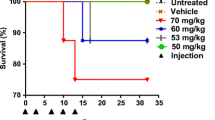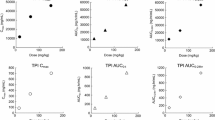Summary
Chronic weekly administration of FUra to CD8F1 female mice bearing spontaneous mammary tumors produced body weight loss during the first 2 weeks of treatment, which became less severe during subsequent weeks of therapy. To our knowledge, the development of such a decrease in FUra toxicity in vivo during chronic treatment with the drug has not been described previously, and a study of this phenomenon was therefore underfaken in tumor-free CD8F1 female mice. Weekly administration of FUra at 85 mg/kg resulted in toxicity expressed in body weight loss and in depressed peripheral WBC levels; however, the magnitude of these toxic effects decreased significantly by the 5th week of treatment. Pretreatment of normal mice with FUra for 7 weeks resulted in a dose-related shift in the LD50 of FUra administered as a subsequent challenge. Compared with an LD50 of 240 mg/kg for FUra in normal mice, the LD50 in mice pretreated with FUra at 50 or 85 mg/kg per week was found to be significantly elevated to 370 and 460 mg/kg, respectively. Pretreatment with FUra at 85 mg/kg for 7 weeks did not alter the activity of the enzymes responsible for the activation of FUra, namely uridine kinase or orotate phosphoribosyltransferase, in the intestinal epithelium or bone marrow, but it did decrease the 24-h urinary excretion of intact [3H]FUra by almost 40% (P<0.01). In addition, the FUra pretreatment schedule resulted in a 31% (P=0.14) increase in the activity of dihydrouracil dehydrogenase in the liver. These results suggest that increased degradation of FUra can be induced by chronic treatment with the drug. Finally, knowledge of the development of increased drug catabolism was used to increase the therapeutic effectiveness, of FUra by its incorporation into an increasing-dose regimen. Mice bearing 24-h transplants of the murine breast tumor were treated with a constant dose of FUra for 12 weeks or with a dose that was increased, after 7 weeks, to a dose normally causing a high degree of drug-related mortality. The group receiving the incremented FUra dose had a significantly slower tumor growth rate without an increase in drug-related toxicity. These results are discussed in light of their obvious clinical implications.
Similar content being viewed by others
References
Ahmed NK (1981) Determination of pyrimidine phosphoribosyltransferase and uridine kinase activities by an assay with DEAE paper discs. J Biochem Biophys Methods 4: 123
Aubert C, Cano JP, Rigault JP, Sertz JF, Carcassonne Y (1981) Pharmacokinetics of 5-fluorouracil: Impact of the measurement of 5,6-dihydrofluorouracil. Bull Cancer (Paris) 68: 343
Brockman RW, Shaddix SC, Rose LM (1977) Biochemical aspects of chemotherapy of mouse colon carcinoma. Fluoropyrimidines and pyrazofurin. Cancer 40: 2681
Canellakis ES (1956) Pyrimidine metabolism. I. Enzymatic pathways of uracil and thymine degradation. J Biol Chem 221: 315
Chaudhuri NK, Montag BJ, Heidelberger C (1958a) Studies on fluorinated pyrimidines. III. The metabolism of 5-fluoruracil-2-C14 and 5-fluororotic-2-C14 acid in vivo. Cancer Res 18: 318
Chaudhuri NK, Mukherjee KL, Heidelberger C (1958b) Studies on fluorinated pyrimidines. VII. The degradative pathway. Biochem Pharmacol 1: 328
Danenberg PV (1977) Thymidylate synthetase — a target enzyme in cancer chemotherapy. Biochim Biophys Acta 473: 73
Darnowski J, Stolfi R, Sawyer R, Martin D, LauCam C (1983) In vivo modification of 5-fluorouracil (FUra)-induced toxicity by chronic treatment with the drug. Proc AACR 24: 302
Hallock RO, Yamada EW (1975) Pyrimidine-reducing enzymes of rat liver. Can J Biochem 54: 178
Harber E, Chaudhuri NK, Heidelberger C (1959) Studies on fluorinated pyrimidines. VIII. Further biochemical and metabolic investigations. J Biol Chem 234: 1255
Harrap KR, Jackson RC (1978) Biochemical mechanisms of resistance to antimetabolites. Fund Cancer Chemother Antibiot Pharmacol 23: 228
Heidelberger C (1965) Fluorinated pyrimidines. Prog Nucleic Acid Res Mol Biol 4: 1
Heidelberger C (1975) Fluorinated pyrimidines and their nucleosides. Springer, Heidelberg New York, p 193
Heidelberger C, Ansfield FJ (1963) Experimental and clinical use of fluorinated pyrimidines in cancer chemotherapy. Cancer Res 23: 1226
Heidelberger C, Kaldor G, Mukherjee KL, Danneberg PB (1960) Studies on fluorinated pyrimidines. XI. In vitro studies on tumor resistance. Cancer Res 20: 903
Houghton JA, Houghton PJ, Wooten RS (1979) Mechanism of induction of gastrointestinal toxicity in the mouse by 5-fluorouracil, 5-fluororuridine and 5-fluoro-2′-deoxyuridine. Cancer Res 39: 2406
Jastreboff MM, Kedzierska B, Rode W (1983) Altered thymidylate synthetase in 5-fluorodeoxyuridine resistant Erlich ascites carcinoma cells. Biochem Pharmacol 32: 2259
Kessel D, Deacon J, Coffey B, Bakamjian A (1972) Some properties of a pyrimidine phosphoribosyltransferase from murine leukemia cells. Mol Pharmacol 8: 731
Krystal G, Webb TE (1971) Multiple forms of uridine kinase in normal and neoplastic rat livers. Biochem J 124: 943
Litchfield JT Jr, Wilcoxon F (1949) A simplified method of evaluating dose-effect experiments. J Pharmacol Exp Ther 96: 99
Lowry OH, Rosebrough NJ, Farr AL, Randall RJ (1951) Protein measurement with the folin phenol reagent. J Biol Chem 193: 265
Martin DS, Fugmann RA, Stolfi RL, Hayworth PE (1975) Solid tumor animal model therapeutically predictive for human breast cancer. Cancer Chemother Rep 5: 89
Miller E (1971) The metabolism and pharmacology of 5-fluorouracil. J Surg Oncol 3: 309
Morse PA, Potter VR (1965) Pyrimidine metabolism in tissue culture cells derived from rat hepatomas. I. Suspension cell cultures derived from the Novikoff hepatoma. Cancer Res 25: 499
Mukherjee KL, Heidelberger C (1960) Studies on fluorinated pyrimidines. IX. The degradation of 5-fluorouracil-6-C14. J Biol Chem 235: 433
Otal-Brun M, Webb TE (1979) Uridine kinase activity in human tumors. Cancer Lett 6: 39
Patterson D (1980) Isolation and characterization of 5-fluorouracil-resistant mutants of Chinese hamster ovary cells deficien in the activities of orotate phosphoribosyltransferase and orotidine-5′-monophosphate decarboxylase. Somatic Cell Genet 6: 101
Reichard P, Skold O, Klein G, Revesz L, Magnusson P (1961) Studies on resistance against 5-fluorouracil. I. Enzymes of the uracil pathway during development of resistance. Cancer Res 22: 235
Reyes P (1968) The synthesis of 5-fluorouridine-5′-phosphate by a pyrimidine phosphoribosyltransferase of mammalian origin. I. Some properties of the enzyme from P1534J mouse leukemia cells. Biochemistry 8: 2057
Sanno Y, Holzer M, Schimke RT (1970) Studies of a mutation affecting pyrimidine degradation in inbred mice. J Biol Chem 245: 5668
Schmid FA, Hutchison DH, Otter GM, Stock CC (1976) Development of resistance to combinations of six antimetabolites in mice with L1210 leukemia. Cancer Treat Rep 60: 23
Skold O, Magnusson P, Revesz L (1962) Studies on resistance against 5-fluorouracil. III. Selective value of resistant, uridine kinase-deficient tumor cells. Cancer Res 22: 1226
Smith AE, Yamada EW (1971) Dihydrouracil dehydrogenase of rat liver. Separation of hydrogenase and dehydrogenase activities. J Biol Chem 246: 3610
Sommadossi JP, Gewirtz DA, Diasio RB, Aubert C, Cano JP, Goldman ID (1982) Rapid catabolism of 5-fluorouracil in freshly isolated rat hepatocytes as analyzed by high-performance liquid chromatography. J Biol Chem 257: 8171
Spiegelman S, Nayak R, Sawyer R, Stolfi R, Martin D (1980) Potentiation of the anti-tumor activity of 5-FU by thymidine and its correlation with the formation of (5-FU) RNA. Cancer 45: 1129
Stolfi RL, Martin DS, Fugmann RA (1971) Spontaneous murine mammary adenocarcinoma: Model system for evaluation of combined methods of therapy. Cancer Chemother Rep [1] 55: 239
Stolfi RL, Sawyer RC, Nayak R, Spiegelman S, Martin DS (1980) Protection by testosterone from fluorouracil-induced toxicity without loss of anticancer activity against autochthonous murine breast tumors. Cancer Res 40: 2730
Ullman B, Kirsch J (1979) Metabolism of 5-fluorouracil in cultured cells. Protection from 5-fluorouracil cytotoxicity by purines. Mol Pharmacol 15: 357
Author information
Authors and Affiliations
Rights and permissions
About this article
Cite this article
Darnowski, J.W., Sawyer, R.C., Stolfi, R.L. et al. Decreased host toxicity in vivo during chronic treatment with 5-flourouracil. Cancer Chemother. Pharmacol. 14, 63–69 (1985). https://doi.org/10.1007/BF00552728
Received:
Accepted:
Issue Date:
DOI: https://doi.org/10.1007/BF00552728




